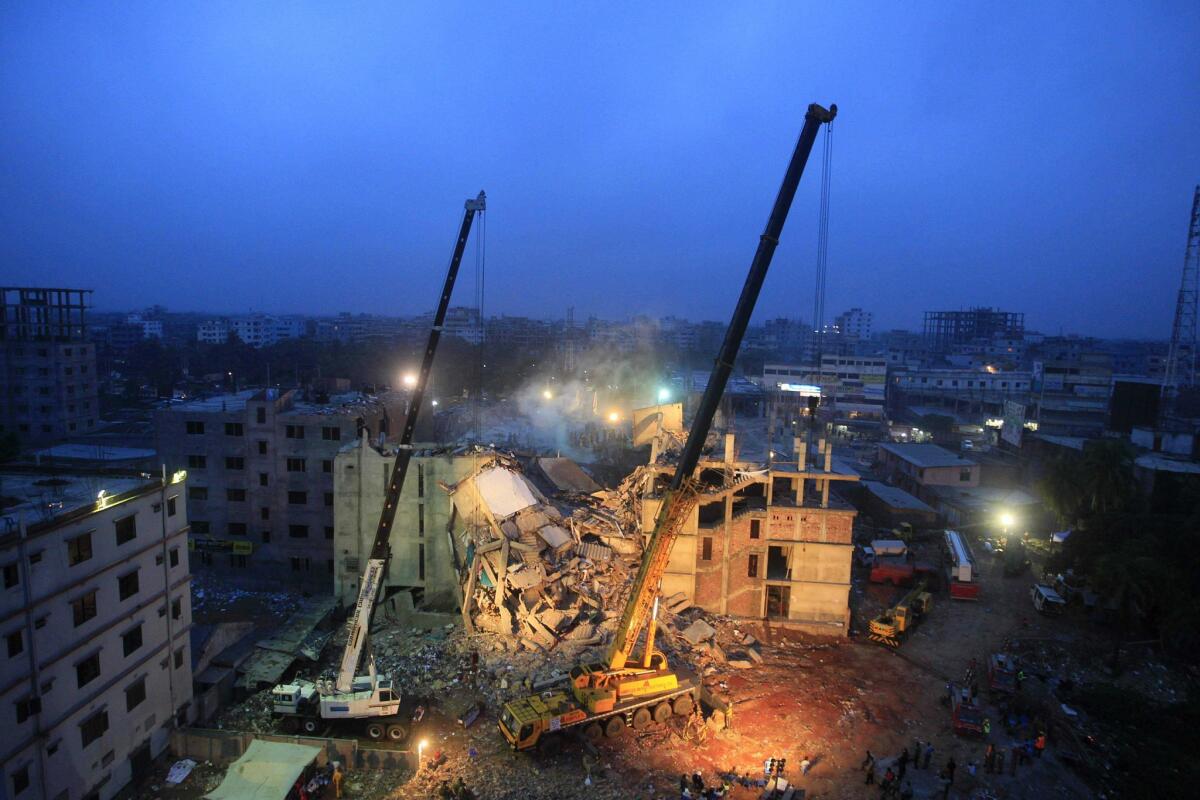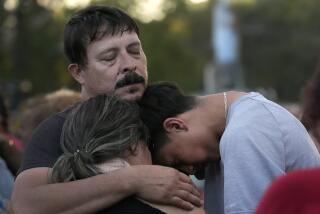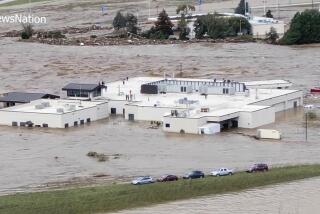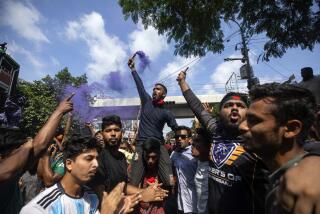Bangladesh factory owner, 41 others charged with murder in 1,100 deaths

Cranes operated by Bangladeshi army personnel are at the scene days after the April 24, 2013, collapse of an eight-story building in Dhaka. Bangladeshi police on Monday charged the owner of the Rana Plaza factory complex and others with murder in the collapse that killed 1,137 people.
- Share via
Reporting from Dhaka, Bangladesh — Two years after a garment factory building collapsed, killing more than 1,100 people and drawing worldwide attention to dangerous conditions in Bangladesh’s apparel business, authorities Monday charged 42 people with murder in the country’s deadliest industrial disaster.
The accused included the owner of the Rana Plaza factory complex, Sohel Rana, and national and local officials who oversaw building safety and inspections. Rana and others initially had been expected to face lesser charges of culpable homicide, but the murder charges mean they could face the death penalty, if convicted.
Authorities said the severity of the charges was due to the scale of the disaster, a signal that Bangladesh was serious about repairing the image of its troubled garment export industry, the second largest in the world and supplier to such major U.S. companies as Gap, Fruit of the Loom, Target, Wal-Mart and Macy’s.
Cheap, submissive labor has propelled Bangladesh’s $20-billion clothing industry, the source of 80% of the country’s exports. Many of the garment manufacturing sector’s 4 million workers are women, which has also driven social change in the overwhelmingly Muslim nation.
Since the disaster, officials have launched a new inspection regime for factories, raised worker pay, allowed unions to register for the first time and pledged other reforms. Major apparel retailers and brands in the United States and Europe formed consortiums to monitor safety at factories that produce their clothes — a sign of how Bangladesh has become a crucial supplier, particularly to low-cost brands.
“They see this as a necessary step to maintain the attractiveness of Bangladesh as a source country, particularly for the U.S. and European markets that are strategically important to the industry,” said Sarah Labowitz, co-director of the Center for Business and Human Rights at New York University’s Stern School of Business.
“The brands need Bangladesh too, because no other country can compete on volume and cost,” Labowitz said. “So we are at a moment where dramatic change is possible because it’s in the interests of both Bangladesh and international companies.”
Yet of the 42 accused on Monday, some two dozen are fugitives — a reminder of the challenges Bangladesh faces in prosecuting suspected abuses in an industry beset by problems.
Even after the minimum wage for garment workers was nearly doubled, it remains just $68 per month, one of the lowest in the world.
Scores of new unions have been formed, but workers say some who tried to unionize have faced intimidation, threats, dismissal and physical attacks by factory managers. Few unions have been able to reach collective bargaining agreements with employers.
“Bangladesh deserves credit for giving unions the leeway they need to organize,” said John Sifton, Asia advocacy director at Human Rights Watch. “But the most important thing is to create institutions that give nascent unions a remedy when factory owners ignore them, crush them or otherwise make them ineffective.”
Workers have long been vulnerable to corrupt, politically connected factory bosses who face little oversight.
On the morning of the disaster in April 2013, authorities say, factory owners and managers ordered reluctant workers to enter the nine-story building a day after large cracks had appeared in the structure. Workers have said that some managers threatened them, in keeping with a feudal labor system in which they were often subjected to physical and verbal abuse, denied bathroom breaks and refused sick leave.
Eighteen of those accused of murder were also charged with violating building codes by adding extra floors to what was originally a five-story complex. About 2,500 people were rescued from the building after it collapsed, many suffering severe injuries.
Rana, owner of the plaza complex on the outskirts of the capital, Dhaka, and active in the Awami League, the political party that runs the country, was arrested days after the collapse while trying to flee to India. He remains in police custody. Rana’s parents were also charged with murder, along with the owners of several other factories in the complex.
Despite pledges by Bangladeshi authorities and international companies, experts worry that the root problems that contributed to the huge death toll at Rana Plaza have not been addressed.
Through two consortiums, American and European brands and retailers such as Adidas, Marks & Spencer and Abercrombie & Fitch have taken responsibility for monitoring workplace and fire safety at about 1,800 supplier factories. But researchers say the total number of factories in Bangladesh is closer to 7,000, including many small- and medium-sized operations that lie outside the reach of international companies and Bangladesh’s own inspection regime — yet employ half of the garment industry workforce.
The government has been busy training inspectors, but has not laid out a clear plan for how to help factories pay for renovations that can reach into the hundreds of thousands of dollars, contributing to a system in which smaller, less well-funded factories remain dangerous.
On Sunday, the day before the Rana Plaza indictments, a fire reportedly caused by a short circuit broke out at a garment factory near Dhaka, causing the top five floors of the seven-story building to collapse. Factory owners said there were no casualties among the 3,000 workers, who were on their lunch break when the fire occurred.
“I totally welcome a criminal prosecution to address the terrible crimes that happened at Rana Plaza,” Sifton said. “But that’s not enough to prevent factory disasters in the future. At the end of the day the real work in improving Bangladesh’s labor situation is in the smaller, mundane issues of labor reform.”
Special correspondent Kader reported from Dhaka and Times staff writer Bengali from Mumbai, India.
Follow @SBengali on Twitter for news out of South Asia
More to Read
Sign up for Essential California
The most important California stories and recommendations in your inbox every morning.
You may occasionally receive promotional content from the Los Angeles Times.











